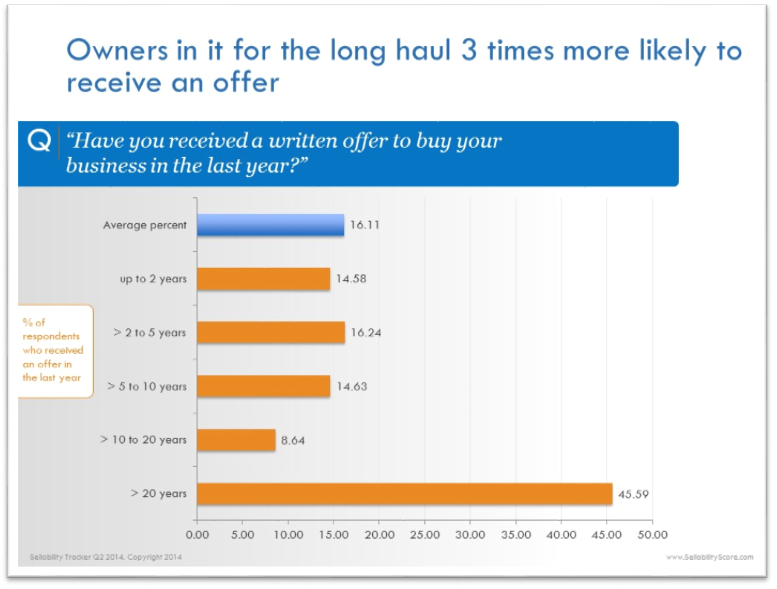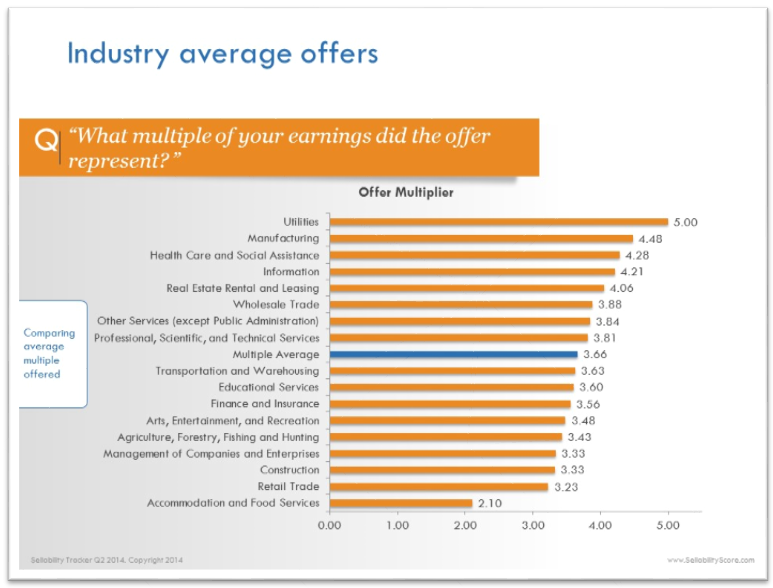Month: September 2014
How To Get a Big Company Multiple For a Small Business
John Warrillow
Big public companies trade at a significant premium over small businesses in the same industry. Investors perceive big, sophisticated companies as a safer bet than small, owner-dependent companies and therefore place a premium on the value of big businesses.
The Secret Great Leaders Know About Being Happy
Most gurus will tell you that the secret to happiness is cultivating a sense of gratitude. But gratitude alone is not enough.

I walked into the kitchen as the sun was rising above the water. My friend–let’s call him Ray–was sitting at an oversized harvest table sipping a coffee made from a machine that costs more than a small car.
The kitchen was complete with every trinket befitting a cashed-out entrepreneur. It was one of probably 20 rooms in a 7,000-square-foot mansion perched above 150 feet of waterfront. I had been invited to stay at Ray’s family home for a few days while passing through on vacation.
Gobsmacked by the setting, and without thinking very much, I asked Ray, “Do you still appreciate this view every morning?”
“Every single morning,” he said.
“Really?” I probed, thinking that even an amazing view like the one I was witnessing would become old after a while.
“Yes, really. It may sound corny, but the overwhelming feeling I get when I look out over the water in the morning is gratitude. I feel so lucky to have two healthy kids and a great wife, and to live in this house.”
(more…)
To Achieve True Happiness, Pursue a Quest
Feeling burned out from the hours and stress of getting your business off the ground? Now may be the time to replace your everyday goals with a quest for something bigger.
Building a business is tiring work. In the beginning, it’s just you. There’s nobody to coach, cajole, or encourage you.
But you keep going anyway. If you stick it out long enough, you may hire a few employees. With full-time staff, you have a built-in motivation to meet payroll, but at some point even having others rely on you can start feeling hollow.
In some ways, having a boss is easier; someone else sets your objectives and holds you accountable. You don’t have to constantly motivate yourself to do more, because someone else is already asking.
Do You Get Motivated By Setting Goals?
As an entrepreneur, the motivation to always carry on has to come from inside you. To cope, a lot of us become compulsive goal setters. Our objectives become our guiding light and the reason we get up in the morning.
(more…)
5 Numbers That Can Predict the Perfect Time to Sell Your Company

You should. The value of your business just went up.
Since 2012, my team at Sellability Score has been analyzing offers entrepreneurs have received to buy their businesses. Every quarter, we look at the average multiple offered, and it is now at its highest point since we started tracking offer multiples.
For the most recent quarter, ending June 30, 2014, the average offer received was four times pretax profit (offers were much higher in some industries and among businesses with certain attributes), or about 10 percent higher than the average multiple offered lifetime of 3.66 times pretax profit.
When the value of your largest asset jumps by 10 percent, it may be tempting to hurry and get your business on the market. After all, isn’t it better to buy low and sell high?
The Downside of Selling at the Peak
The thing many of us forget is that when you sell your company–possibly your largest asset and the biggest wealth-creating event of a lifetime–you have to do something with the money you make.
These days, that means you’ll have to turn around and invest your windfall into an asset class that is equally bubbly. The stock market has more than doubled since 2009. The price of residential real estate has been growing at a rate of 1 percent per month in many major centers. The same trend can be seen in many markets that offer exclusive beach houses or ski chalets. (more…)
Increasing Business Value: Increase Earnings or Decrease Risk?
Are Your Company’s Earnings or Risk Factors More Relevant For Your Successful Exit?
Most business owners at some point in time want to know the value of their privately-held business. Further, many owners who see their ‘exit’ as being many years in the future would like to know what they can do today to improve and grow that value. This newsletter asks a rather simple question for owners to consider today, “is it better to increase your profits or to reduce your ‘transition risk’ in order to increase the value of your business?”
The Risk and Return Formula For Valuations
A buyer of a business will pay for the cash flows that they believe will happen in the future, which is measured by the overall riskiness of those forecasted cash flows being achieved.
Let’s translate this a bit further. A business is worth what someone else is willing to pay for it – that is the ‘price’ at which a business may sell. However, the ‘value’ of a business today can only be measured using certain specific ideas about how a future buyer would view the business. As a general rule, buyers will pay for future cash flows but only at a rate at which the riskiness is properly reflected. Therefore, a complete analysis of how to increase the value of your business must include both increasing profits (i.e. cash flows) as well as analyzing and reducing risks in the business.
EBITDA Multiples
Many owners are familiar with ‘industry multiples’ for sales of businesses. For example, many owners will understand what it means when someone says that “Jim sold his manufacturing company for ‘5 times’ the company’s earnings”. The ‘5 times’ is simple to understand. Jim’s company, in this example, had a certain amount of annual profitability and the buyer of Jim’s company paid 5 times that number. For example, if Jim’s company had $1 million in annual profit, the buyer paid $5 million for the business – simple enough.
Increasing Profit as the Default for Increasing Value
Using the example above, many owners in the same industry as Jim will forecast a realistic sale price for their own business by looking to these standard metrics such as the ‘multiple of earnings’ under the theory that similar businesses (i.e. their business) will sell at a similar price. This often leads business owners to the quick conclusion that the easiest way to increase the value of their business is to increase their own company’s earnings. Why wouldn’t an owner think in this logical way?
However, the question that is less frequently asked is “what is comprised of the ‘5 times’ multiple and does my business have the same risk factors as Jim’s in the example above?”
Deriving a Multiple from the Risk Factors in a Business
To understand multiples, one must first see that a buyer is paying a certain multiple because of their perceived riskiness of the future cash flows of that business. There are many factors that impact the riskiness of a business and, therefore, impact the value.
For example, let’s assume that Jim had a solid management team in place and only worked in the business one (1) day a week. When a buyer sees that they will gain access to the same management team when they purchase the business, they see less risk in the transition of the company and that element factors into the multiple that they pay. Whereas if you are running your business by making day-to-day decisions and taking little or no vacation time, most buyers will see more risk because you represent a single point of failure for the business. In this case a buyer would see more risk and would, therefore, pay a lower price – all things being equal.
So, in an attempt to answer the primary question in this newsletter, one must ask themselves whether it is easier to increase the profitability of your business (i.e. grow cash flow) or is it easier to staff the company with an initial quality manager or two in order to reduce the risk?
There is no right answer to this question. However, this newsletter is written to challenge your conventional thinking about increasing the value of your business.
Other Risk Factors that Impact the Multiple
Let’s assume that you are of the mindset that it is easier to hire a manager or two than it is to increase your company’s profitability over the next few years. You might then be asking what else you can do to reduce the riskiness of your business in order to increase the multiple that you may receive. Here are a few items:
- Improve the quality of your financial reporting.
- Reduce customer or vendor concentration.
- Have a clearly defined, written strategy for company growth that is shared with others in the company.
- Improve your procedures and operations manuals.
- Document and execute on dynamic marketing and selling programs.
These are just a few of the ‘non-cash-flow’ components of your business that will reduce ‘transition risk’ and will help you to increase the value of your company.
Reducing Risk is About More than Increasing Value Alone
Hopefully by this point in the newsletter you are seeing that there are many factors that go into the value of a business and many ‘risk reducing’ measures that can be taken to increase your value.
That being said, it is important to also point out that reducing risk is not just about increasing value, it is also about making your company more saleable overall. You see, if a buyer sees too many risks in your business it is just as likely as not that they will walk away from the transaction as opposed to reducing the overall purchase price. Many buyers don’t want to fix a business that they consider broken – it’s easier for them to find one that has less risk and is easier for them to run profitability in the future. The translation is that by ignoring risk and only focusing on increasing profits, you might actually scare buyers away, therefore eliminating the ‘gains’ that you felt you would achieve by simply increasing your profits.
Concluding Thoughts
Every business owner will one day exit their business. Some will get paid top dollar while others will spend years trying to ‘get out’. This newsletter attempts to make the point that it may be easier, cheaper and more efficient for you to focus on reducing risk before jumping right into the process of trying to increase the value of your company by growing profits. We hope that this newsletter has you thinking more about your future exit and what you can do today to increase the success of that future transaction.
Pinnacle Equity Solutions © 2014
Frank Mancieri, Chief Growth Advisor, GT Growth & Transition Strategies, LLC, 401-651-1585, frank@gtGrowth.com



